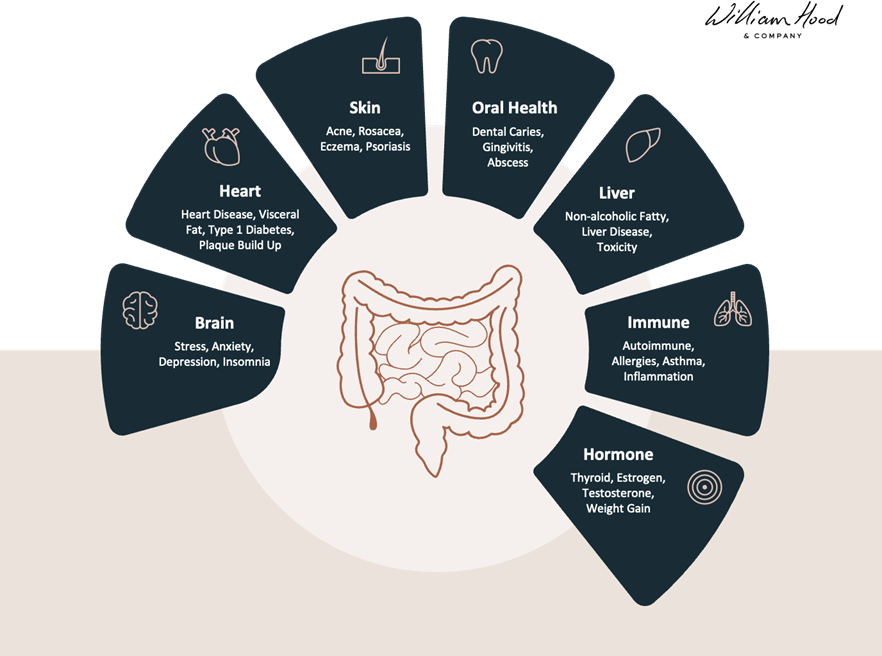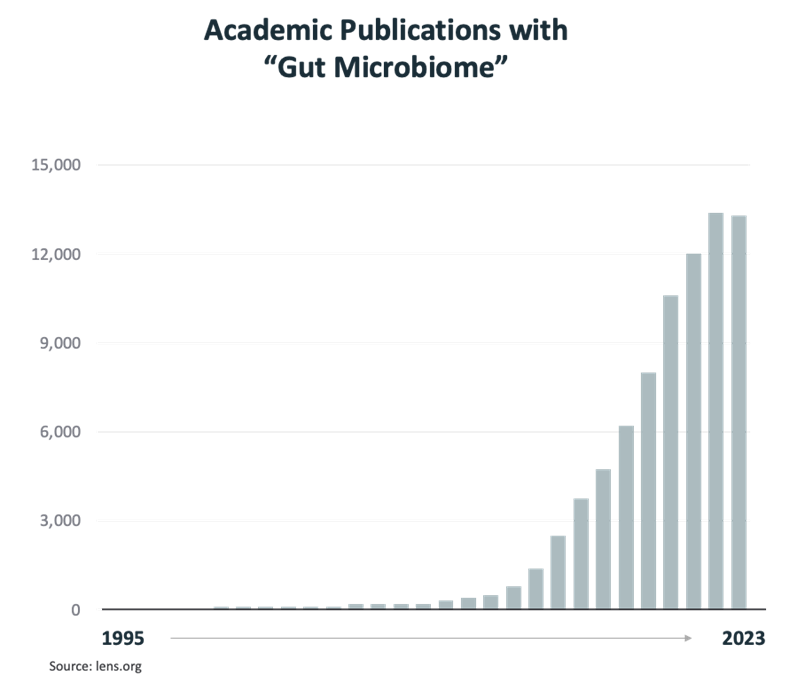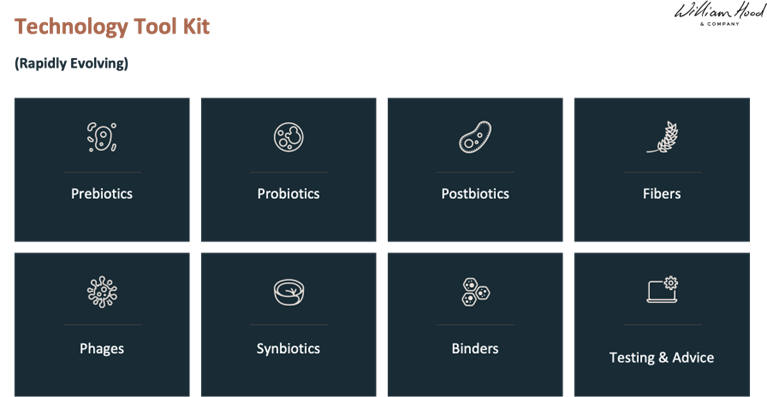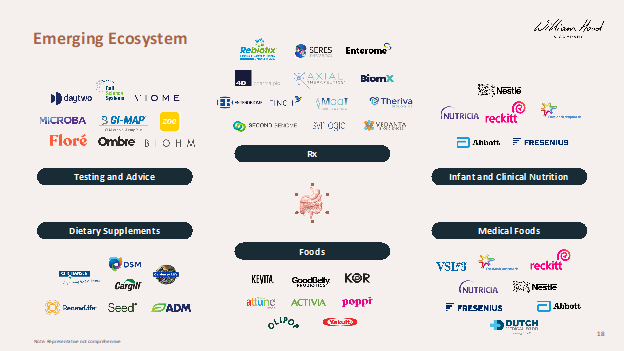Greg Horn’s business of nutrition: The gut microbiome
In his quarterly "business of nutrition" column, Greg Horn of William Hood & Company explores the growing science and excitement over the gut microbiome.

The 2024 Future of Microbiome Winter Summit conference brought together thought-leaders across the gut microbiome space globally to discuss emerging technologies, new scientific research, relevant business developments, and where this rapidly evolving field might be headed.
I have seen the commercial side of the category evolve from selling generic acidophilous at GNC to the first soil-based organisms (now called shelf-stable probiotics) at Garden of Life to being at Flagship Pioneering when Seres and other microbiome drug-development companies were born. My comments are focused on the drivers that make this an exciting category and why the gut microbiome is such a rich frontier of innovation with significant health and business implications.
Gut microbiome: It’s complicated
Noting that expert estimates vary even on the basics, the human body is comprised of about 10 trillion human cells — with around an additional 100 trillion cells within the long, dark tube of a healthy gut microbiome. These bacteria, fungi and even viruses have co-evolved to become people’s partners in health, assisting with the daily work of converting food to energy and nutrients for repair and growth, as well as serving as a front line for avoiding infections. These tiny partners form an ecosystem within the gut that has an enormous impact on health.
Each of the 100 trillion organisms within the gut has its own DNA and mini-metabolism that digests certain elements of one’s diet and spits out metabolites — the interactions are dynamic and staggeringly complex. They are also strongly influenced by inputs such as the fibers, fats, carbohydrates, proteins and micronutrients in the diet; any prebiotics and probiotics taken as dietary supplements; drugs and alcohol; and even nondietary inputs like pollution exposure and stress reactions. This dynamism and complexity, and the strong link to a wide range of health outcomes, have made the gut microbiome field irresistible to modern science.
Microbiome by the numbers
It surprised me when I first learned that the separation between the contents of the colon and “you” can be as little as one cell thick at the epithelial layer lining the intestines. That’s just one of many eye-opening numbers (from APC Microbiome Ireland below) that provide insight and perspective into the potential of the gut microbiome and health.
100 trillion symbiotic microbes live in and on every healthy person.
95% of the human microbiota is located in a person’s gastrointestinal (GI) tract.
150:1 is the ratio of the genes in a person’s microbiome to their human genome.
4.4 lbs is the dry weight of one’s gut microbiome.
2 is the number of tennis courts it would take to house a stretched-out GI tract.
10,000+ is the number of microbial species that science has identified so far living in and on the human body.
2.5 is the number of times the cells in the body’s microbiome would circle the earth if placed end to end.
Why all the excitement?
Scientists and businesspeople are excited about the gut microbiome because of its potential impact on a range of health conditions, combined with its ability to be strongly influenced by inputs.
The digestive tract is now understood to have an enormous impact on other systems of the body, including the brain, heart, skin, liver, hormones and immune function.

Science is just starting to understand how some of these linkages actually work, which provides insight into how they can be influenced to positively impact health. Understandably, much of the current science is focused on acute gut-related problems that can kill patients in the short term, like otherwise super-hard-to-treat C. difficile infections.
Opportunity attracts science (and money)
With the advent of antibiotics, medicine acquired a powerful and lifesaving tool and used it liberally. Since there was almost no understanding of the central role that the gut microbiome played in health, antibiotics were used to eradicate everything that might harm health in the short term. The rainforest that is a person’s microbiome ecosystem was not understood, but pathogens were known to be bad, so the whole forest was incinerated as standard practice. As the chart below shows, almost no academic publications mentioned the gut microbiome before 2010. In 2023 alone, over 13,000 such publications existed.

As one would expect, academic insights lead to patentable inventions for medicines, treatment protocols and devices that can link gut microbiome insights to better health outcomes. This dynamic has driven a boom in patent application activity, from almost zero in 2010 to over 2,000 new applications per year currently. These patents will form the foundation for a whole new generation of medicines, dietary supplements and protocols that will be used for decades to come.

Tiny organisms = big business
Because of their outsized impact on health, these tiny little partners in health are now a big business globally. According to Grandview Research, digestive health products were a $47.8 billion global market in 2022, forecasted to grow at 8.2% heading into 2030.
While microbiome therapeutics is currently a smaller global market, coming in at $94.8 million in 2022, the U.S. segment therapeutics is expected to grow in excess of 38% through 2030, again according to Grandview Research.
Technology toolkit
The technology toolkit has improved exponentially since the days when product developers were trying to keep acidophilus alive and find manufacturing plants that would handle spore probiotics. The ingredients ecosystem that powers the industry has been hard at work. Today, product developers have a vast array of clinically backed ingredients from which to create effective digestive health products.

Emerging commercial ecosystem
Given the rapidly expanding body of research on the gut microbiome’s potential impact on health and the robust growth in the ingredients toolkit, it’s not surprising that an ecosystem of exciting companies is emerging. Companies are pursuing innovative gut health products, protocols and therapies across a diverse array of fields — from testing and advice to foods, dietary supplements, medical foods, infant and clinical nutrition, and of course, therapeutics.

Evidence of potential: Pharma deals
As further evidence of the potential for microbiome therapeutics to impact health, big pharma companies are eager to get in on the action by investing in and collaborating with upstart microbiome players, often with tens and even hundreds of millions of dollars at stake. A sampling of these deals is captured below:

World-class insight
The Future of Microbiome conference attracted experts from all over the world who shared their perspective on the opportunities represented by the emerging understanding in this dynamic field. Of particular note:
Noah Voreades’ thought-provoking presentation shared disruptive influences in the gut microbiome space. These influences included testing and the insights gained from what can now be seen and measured, impact on the gut microbiome on future glucagon-like peptide-1 (GLP-1) agonist iterations, innovative ways of monetizing gut-healthy products, personalization in partnership with retailers, and even linking gut microbiome insights and management to longevity.
The brilliant Denise Kelly, Ph.D., of Seventure, a lifelong microbiome researcher and drug developer, talked about the serious scientific end of the gut microbiome field: Curing and preventing diseases that shorten life and cause suffering, along with hints of some future consumer applications from the enormous flows of investment money coming into the space.
Mike Bush of GrowthWays, an experienced executive in the microbiome space having built Ganeden’s BC30 ingredient business into a powerhouse, spoke to the entrepreneurial innovators in the gut microbiome space with insights about how to grow a valuable brand with patents, proof and policing intellectual property (IP).
Trust your gut: Continued growth
While this article summarizes a brief overview of the scientific and business developments in the microbiome arena, the “gut feeling” consensus from the conference was that continued growth will emerge in the science, as well as a burgeoning toolkit of effective ingredients and commercial applications in the gut microbiome space.
Thanks for reading.
About the Author
You May Also Like

